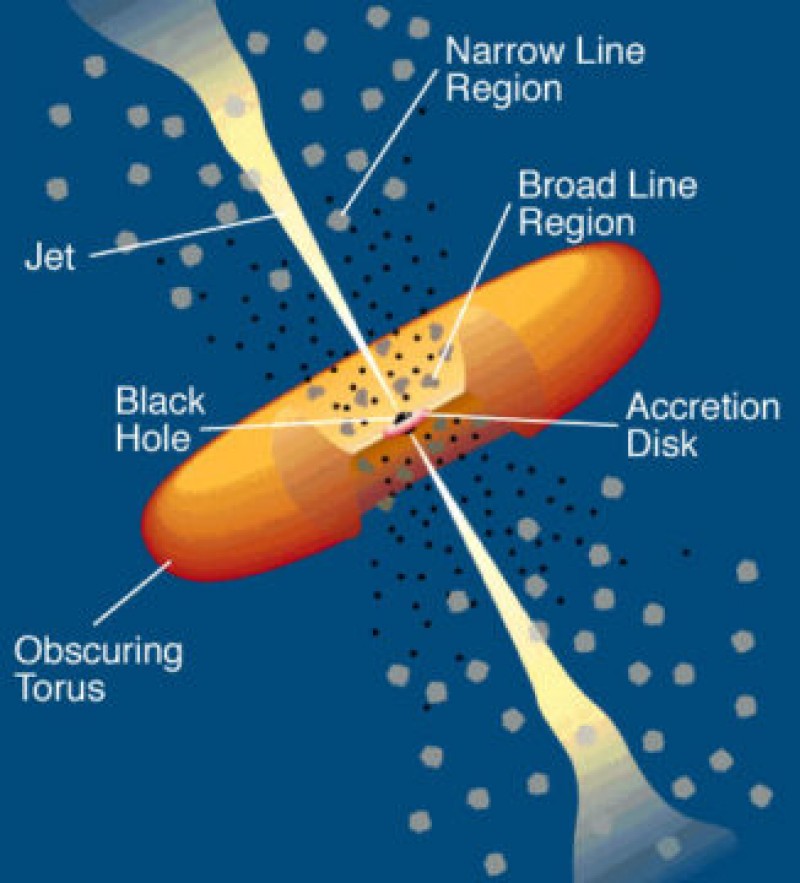From car tires to chocolate-frosted donuts to infinity scarves, the torus is a relatively common shape in modern life. But the same can’t be said for nature, where globular shapes and thin disks are far more typical.

That’s why the torus is one of the more striking features of active galactic nuclei(AGN). In AGN supermassive black holes are gorging on gas, which heats up until it’s radiating more brightly than the entire host galaxy. But decades of indirect data show that these luminous behemoths often hide behind a fat, dusty torus. To explain observations, the torus must cover half of the AGN’s sky, which means it must be roughly as fat as it is tall — somewhere around 3 light-years for both dimensions.
Such a structure ought to collapse into a disk within 100,000 years. Instead, they apparently stick around for hundreds of millions of years — and astronomers still don’t know why.
That’s beginning to change with observations of Messier 77 (M77, aka NGC 1068), a black hole 10 million times the mass of the Sun that’s partially hidden by its encircling torus. The Atacama Large Millimeter/submillimeter Array (ALMA), high in the Atacama Desert in Chile, can image the torus itself, capturing the rotating, outflowing, and turbulent motions of its gas.

ALMA captured dense gas (inset) at the center of spiral galaxy Messier 77 (background), as imaged by the Hubble Space Telescope. The horseshoe-like structure spans 1,400 light-years and the central spot — the AGN torus — is 40 light-years wide. In the inset, red indicates emission from formyl ions (HCO+) and green indicates emission from hydrogen cyanide (HCN) molecules.
Inset: ALMA (ESO/NAOJ/NRAO) / Imanishi et al. Background: NASA / ESA Hubble Space Telescope & A. van der Hoeven
In 2016 Santiago García-Burillo (National Astronomical Observatory of Madrid) and Jack Gallimore (Bucknell University) led teams reporting ALMA observations of M77 that peer into the galaxy’s core. Both teams used carbon monoxide molecules to trace vastly more abundant (but more difficult to observe) molecular hydrogen gas. While Garcia-Burillo’s team captured turbulence in the torus, Gallimore’s group caught an outflow, presumably coming from the accretion disk, that’s blowing into (and puffing up) the torus.
Now, Masatoshi Imanishi (National Astronomical Observatory of Japan) and colleagues have imaged M77’s torus in even greater detail, with images twice as sharp as previous ones. The results appear in Astrophysical Journal Letters.
The team measured hydrogen cyanide — while it’s a poisonous acid on Earth, it serves as a tracer of dense hydrogen gas in space. Because their observations follow denser gas, they’re able to capture the rotational motions of the torus. The 20 light-year-wide donut orbits the supermassive black hole at roughly 10 kilometers per second (20,000 mph).

This image shows gas moving around M77's supermassive black hole. The gas moving toward us is shown in blue and that moving away from us is in red. The gas’s rotation is centered around the black hole (unseen).
ALMA (ESO / NAOJ / NRAO) / Imanishi et al.
However, further analysis indicates that there’s a lot more to the torus than rotation — their observations are consistent with the previous results showing other motions (turbulence and outflows) that sustain the torus.
“ALMA is doing a fantastic job exposing the secrets of NGC 1068, and the observations are only getting better,” Gallimore says.